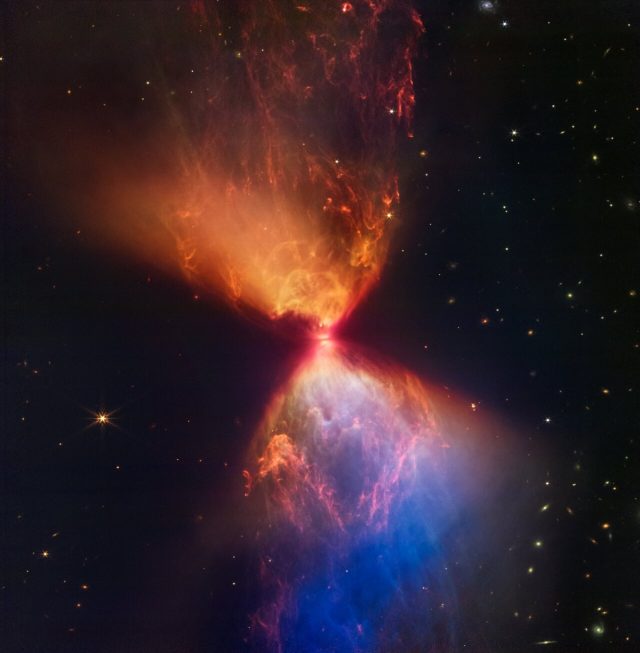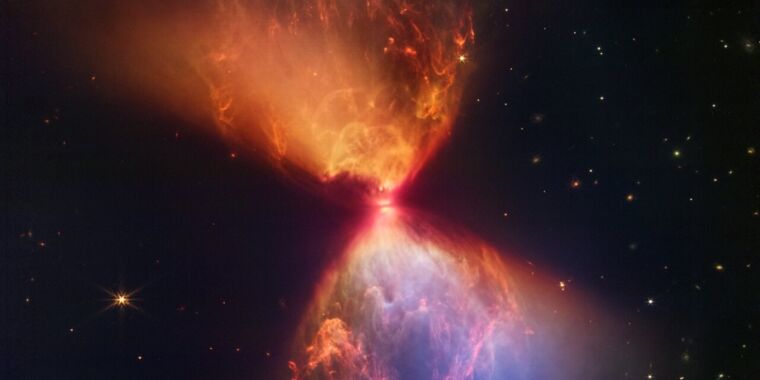The protostar L1527 is embedded within a cloud of material that is feeding its growth.
Just last month, the James Webb Telescope gifted us a spectacular new image of the Pillars of Creation—arguably the most famous image taken by Webb’s predecessor, the Hubble Space Telescope, in 1995. Now the telescope is giving astronomers clues about the formation of a new star, with a stunning image of an hourglass-shaped dark cloud surrounding a protostar, an object known as L1527.
As we’ve reported previously, the James Webb Space Telescope launched in December 2021 and, after a suspenseful sunshield and mirror deployment over several months, began capturing stunning images. First, there was the deep field image of the Universe, released in July. This was followed by images of exoplanet atmospheres, the Southern Ring Nebula, a cluster of interacting galaxies called Stephan’s Quintet, and the Carina Nebula, a star-forming region about 7,600 light-years away.
In August, we received gorgeous images of Jupiter, including the auroras at both poles that result from Jupiter’s powerful magnetic field, as well as its thin rings and two of the gas giant’s small moons. This was followed a month later by a mosaic image showing a panorama of star formation stretching across a staggering 340 light-years in the Tarantula Nebula—so named because of its long, dusty filaments. We also were treated to spectacular images of Neptune and its rings, which have not been directly observed since Voyager 2 flew by the planet in 1989, and, as already mentioned, the Pillars of Creation.
This latest image is courtesy of Webb’s primary imager, the Near-Infrared Camera (MIRCam). To capture images of very faint objects, NIRCam’s coronagraphs block any light coming from brighter objects in the vicinity, similar to how shielding one’s eyes from bright sunlight helps us focus on the scene in front of us. The dark clouds of L1527 are only visible in the infrared, and NIRCam was able to capture features that had previously been hidden from view. Check it out:

NASA/ESA/CSA/STScI/J. DePasquale
Back in 2012, astronomers used the Submillimeter Array—a collection of eight radio telescopes arranged into an interferometer that is also part of the Event Horizon Telescope—to study the accretion disk around L1527 and measure its properties, including the rotation. They found that the disk exhibited Keplerian motion, much like the planets in our Solar System, which enabled them to determine the mass of the protostar. So learning more about L1527 could teach us more about what our own Sun and Solar System were like in their infancy.
Protostars are the earliest stage in stellar evolution, typically lasting about 500,000 years. The process begins when a fragment of a molecular cloud of dense dust and gas gains sufficient mass from the surrounding cloud to collapse under the force of its own gravity, forming a pressure-supported core. The nascent protostar continues to draw mass to itself, and the in-falling material spirals around the center to create an accretion disk.
The protostar within L1527 is only 100,000 years and thus doesn’t generate its own energy from nuclear fusion that turns hydrogen into helium, like a full-fledged star. Rather, its energy comes from the radiation released by shockwaves on the surface of the protostar and its accretion disk. Right now, it’s basically a sphere-shaped puffy clump of gas between 20–40 percent the mass of our Sun. As the protostar continues to gain mass and compress further, its core will continue to heat up. Eventually it will get hot enough to trigger nuclear fusion, and a star will be born.
The Webb image above shows how material ejected from L1527’s protostar has created empty cavities above and below; the glowing orange and blue regions represent the boundaries outlining those regions. (The blue region’s color is because it has less dust, compared to the orange regions above it, which trap more blue light in the thick dust so it can’t escape.) The accretion disk appears as a dark band. There are also filaments of molecular hydrogen in the image, the result of shocks from the protostar ejecting material.
Listing image by NASA/ESA/CSA/STScI/J. DePasquale








